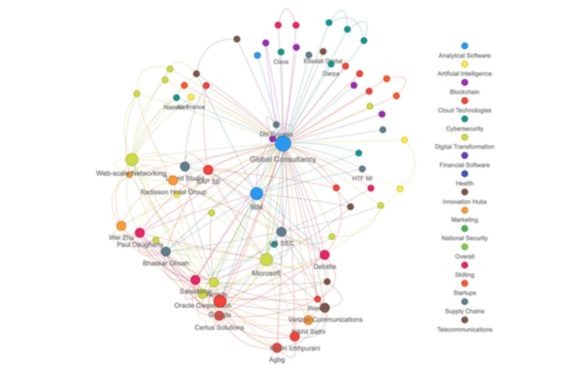To help our clients use their business model to build their influence and reputation, Handshake has developed Navigator, a business intelligence platform based on network science.
As we have previously written, “Networks are made up of people and organizations sharing ideas and information through all forms of communication – conversations, social media, participation at events, and so on. As a result, networks are the infrastructure of influence, driving the exchange of resources and ideas.”
Almost twenty years ago Robert Kelley of Carnegie Mellon University made a very astute observation about the value provided by networks: “Better-connected and faster networks allow the stars to turbo-charge their productivity, so that they outpace the average performers, who might have similar talent, but go it alone.” In other words, it is through networks that concepts become reality, meaningful change occurs, and human progress accelerates.
Below is a map that depicts an ecosystem of partners created by a global consultancy. This type of network mapping helps organizations understand the depth and breadth of their network and how partners can be used to further scale organizational initiatives.

Traditional Media and Viral Contagion
The methodology by which Handshake analyzes networks involves looking at multiple layers of conversations in the public domain – social media conversations, published research material, transcripts from conferences and panels, and so on. But, the foundation for our research is looking at traditional media coverage.
There are three reasons for media coverage serving as the foundation for our network analysis.
First, as Robert Cialdini noted in his recent book, Pre-Suasion, while the media may not tell us how to think, it does tell us what to think about. In other words, the media is a transmitter of ideas being shared by influencers.
Second, as anyone who has pitched a reporter can attest, getting an idea into a publication is no easy feat. You first must get the reporter interested in the idea. The reporter then will seek additional, independent sources to validate the idea. Finally, the idea needs to pass muster with the editors and the fact checkers. In other words, if an idea can make it into a publication like the Wall Street Journal, Bloomberg Businessweek, or the Financial Times, it most likely has merit.
Third, traditional media is the quickest, most efficient avenue for an idea to “go viral”. As Damon Centola wrote in the Winter 2019 issue of MIT Sloan Management Review, there are two ways for an idea to go viral. First, it can spread through a “simple contagion” – a single, activated contact – such as two friends having a conversation. Alternatively, ideas spread through a “complex contagion” that involve multiple points of exposure simultaneously reaching a wide audience.
It is the difference between simple and complex contagions that make traditional media platforms more powerful for spreading ideas than social media platforms. Social media contacts are often defined as “strong” – people in a social network are tightly connected because they often know each other and share many of the same beliefs. And, many of the contacts in a social network are redundant between people (just look at the number of mutual connections between you and your Facebook friends).
In contrast, traditional media platforms are built on weak ties among much wider groups of people. As Centola noted, sharing an idea among weak ties gives “your idea reach by creating an invisible link from your network to parties to which you have no direct access.”
Ideas more quickly spread through reach, not redundancy. Given the circulation and online presence of traditional media platforms dwarfs that of most individual social media accounts, the ideas conveyed reach a far greater number of influencers much more quickly.
What this Means for Influencers
Taken together, these three points argue that, if an individual or an organization wants to understand the actors in a network and the ideas they are sharing, analyzing traditional media coverage is the best place to start when developing a strategy to influence the network.
That is not to argue that pitching stories to news outlets or engaging reporters is a panacea for building influence.
We will discuss further in upcoming posts to the Handshake blog but securing a meaningful place in a network requires an all-encompassing approach. Beyond the media, influencers must deploy all available resources at their disposal to build influence in the network – creating insightful content, participation in prominent events and conferences, and using social media to further engage actors in the network.

